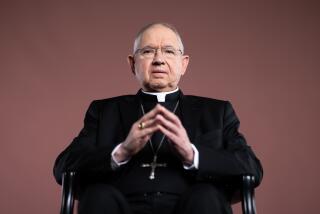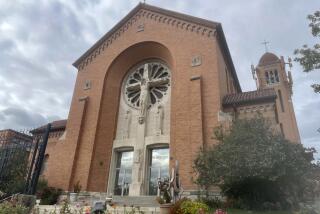‘Archbishop Sean’ Goes for Urban Digs
- Share via
BOSTON — The new archbishop of Boston announced Friday that he would live in a downtown rectory, not the opulent mansion his predecessors used.
In a column published Friday in a religious newspaper, Archbishop Sean Patrick O’Malley explained that he wanted to live close to the Cathedral of the Holy Cross, where he often officiates on Sundays.
“The parish is the venue of the pastoral life of the diocese, and living in a rectory is a statement about this reality,” O’Malley wrote in the Pilot, the newspaper of the Roman Catholic archdiocese of Boston. He added that the presiding monsignor “graciously invited” him to reside at the cathedral in Boston’s South End district.
Revealing more self-deprecating humor, which had peppered his recent installation homily, O’Malley wrote: “Some rectors might not be so anxious to have the bishop living upstairs.”
O’Malley, 59, is a Capuchin friar who wore the rough brown robes of his order under his formal chasuble as he accepted his appointment as head of one of the country’s largest and most troubled archdioceses. At the same ceremony, O’Malley gestured to his large contingent of family members, referring to them as his “great big fat Irish wedding.”
O’Malley succeeds Cardinal Bernard Law, who resigned in disgrace last December as a result of the massive sexual abuse scandal that began here more than a year and a half ago.
A recent report by the state attorney general implicated about 250 priests and church officers in a child-molestation scandal that stretches back 60 years.
Law, who did not attend O’Malley’s investiture, chose to live in a palatial residence on the grounds of chancery headquarters. The two cardinals who preceded Law also lived in the official archbishops’ mansion.
Under Law’s nearly 20-year tenure, a lavish annual garden party at the archbishops’ residence became one of the most coveted invitations in the city’s social calendar.
O’Malley stressed in his column that he was embarrassed by comparisons to his predecessors.
“I can assure you that [they] were not worldly men who sought a ‘fancy pad,’ ” he wrote.
He also noted that the mansion adjacent to Boston College had symbolic value for Catholics in Boston.
“There was a day when many of the trappings surrounding the bishop were an expression of the longing of immigrant Catholics for acceptance in their new homeland,” wrote O’Malley, who has asked to be known as “Archbishop Sean.”
“It was the way Catholics said: ‘We are here too. Our church is an important institution, and we are important,’ ” he continued.
O’Malley said the mansion would be used for offices. He also said he regretted the attention cast on what he considered a simple logistical decision. “I would have preferred to sneak out with my suitcase in the middle of the night,” O’Malley wrote, “but that is not feasible.”
More to Read
Sign up for Essential California
The most important California stories and recommendations in your inbox every morning.
You may occasionally receive promotional content from the Los Angeles Times.










